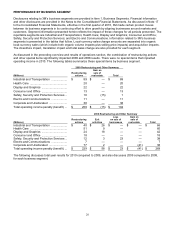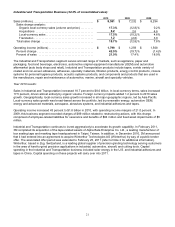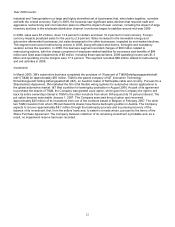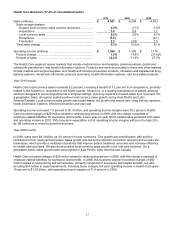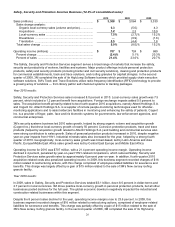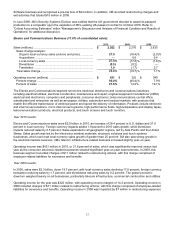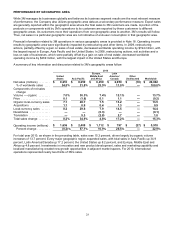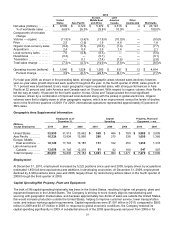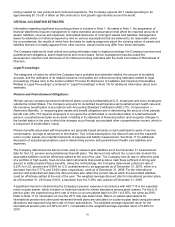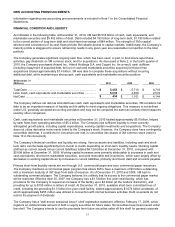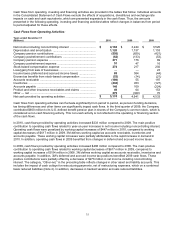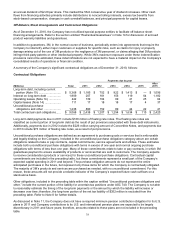3M 2010 Annual Report Download - page 36
Download and view the complete annual report
Please find page 36 of the 2010 3M annual report below. You can navigate through the pages in the report by either clicking on the pages listed below, or by using the keyword search tool below to find specific information within the annual report.30
tooling needed for new products and continued operations. The Company expects 2011 capital spending to be
approximately $1.3 to $1.4 billion as 3M continues to fund growth opportunities around the world.
CRITICAL ACCOUNTING ESTIMATES
Information regarding significant accounting policies is included in Note 1. As stated in Note 1, the preparation of
financial statements requires management to make estimates and assumptions that affect the reported amounts of
assets, liabilities, revenue and expenses, and related disclosure of contingent assets and liabilities. Management
bases its estimates on historical experience and on various assumptions that are believed to be reasonable under
the circumstances, the results of which form the basis for making judgments about the carrying values of assets and
liabilities that are not readily apparent from other sources. Actual results may differ from these estimates.
The Company believes its most critical accounting estimates relate to legal proceedings, the Company’s pension and
postretirement obligations, asset impairments and income taxes. Senior management has discussed the
development, selection and disclosure of its critical accounting estimates with the Audit Committee of 3M’s Board of
Directors.
Legal Proceedings:
The categories of claims for which the Company has a probable and estimable liability, the amount of its liability
accruals, and the estimates of its related insurance receivables are critical accounting estimates related to legal
proceedings. Please refer to the section entitled “Process for Disclosure of Liabilities and Insurance Receivables
Related to Legal Proceedings” (contained in “Legal Proceedings” in Note 14) for additional information about such
estimates.
Pension and Postretirement Obligations:
3M has various company-sponsored retirement plans covering substantially all U.S. employees and many employees
outside the United States. The Company accounts for its defined benefit pension and postretirement health care and
life insurance benefit plans in accordance with Accounting Standard Codification (ASC) 715, Compensation —
Retirement Benefits, in measuring plan assets and benefit obligations and in determining the amount of net periodic
benefit cost. ASC 715 requires employers to recognize the underfunded or overfunded status of a defined benefit
pension or postretirement plan as an asset or liability in its statement of financial position and recognize changes in
the funded status in the year in which the changes occur through accumulated other comprehensive income, which is
a component of stockholders’ equity.
Pension benefits associated with these plans are generally based primarily on each participant’s years of service,
compensation, and age at retirement or termination. Two critical assumptions, the discount rate and the expected
return on plan assets, are important elements of expense and liability measurement. See Note 11 for additional
discussion of actuarial assumptions used in determining pension and postretirement health care liabilities and
expenses.
The Company determines the discount rate used to measure plan liabilities as of the December 31 measurement
date for the U.S. pension and postretirement benefit plans. The discount rate reflects the current rate at which the
associated liabilities could be effectively settled at the end of the year. The Company sets its rate to reflect the yield
of a portfolio of high quality, fixed-income debt instruments that would produce cash flows sufficient in timing and
amount to settle projected future benefits. Using this methodology, the Company determined a discount rate of
5.23% for U.S. pension and 5.09% for U.S. postretirement to be appropriate as of December 31, 2010, which is a
decrease from the 5.77% and 5.62% rates, respectively, used as of December 31, 2009. For the international
pension and postretirement plans the discount rates also reflect the current rate at which the associated liabilities
could be effectively settled at the end of the year. The weighted average discount rate for international pension plans
as of December 31, 2010 was 5.04%, a decrease from the 5.30% rate used as of December 31, 2009.
A significant element in determining the Company’s pension expense in accordance with ASC 715 is the expected
return on plan assets, which is based on historical results for similar allocations among asset classes. For the U.S.
pension plan, the expected long-term rate of return on an annualized basis for 2011 is 8.50%, the same as 2010.
Refer to Note 11 for information on how the 2011 rate was determined. Return on assets assumptions for
international pension and other post-retirement benefit plans are calculated on a plan-by-plan basis using plan asset
allocations and expected long-term rate of return assumptions. The weighted average expected return for the
international pension plan is 6.58% for 2011, comparable to the weighted average expected return of 6.90% for
2010.


